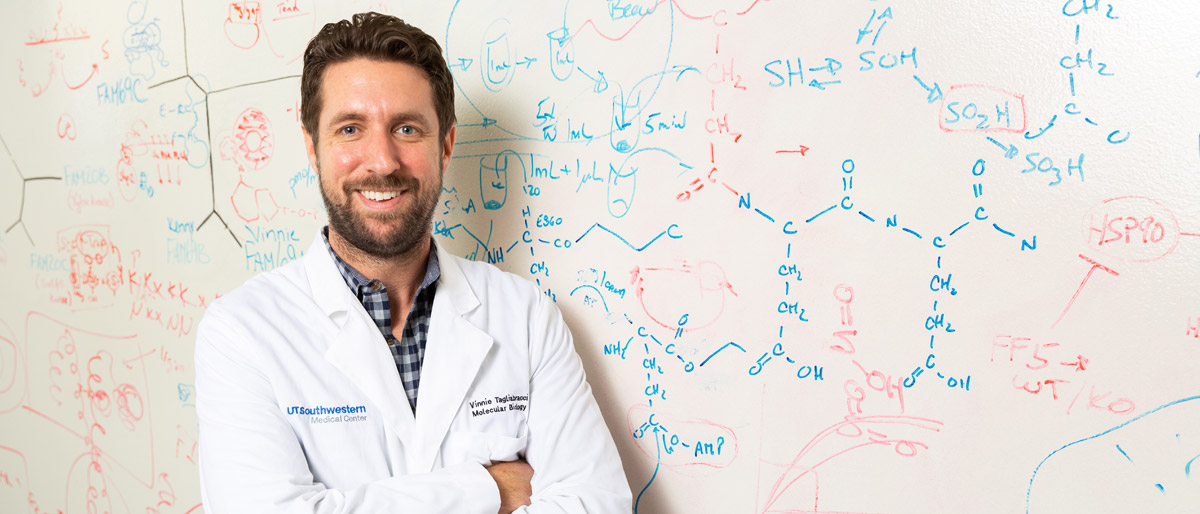Tagliabracci honored with NIH New Innovator award

Molecular biologist Dr. Vincent Tagliabracci is one of 60 researchers across the country selected for an award in a National Institutes of Health program supporting highly innovative science.
His project, “Breathing Life into Dead Enzymes,” received a New Innovator award from the NIH Director’s High-Risk, High-Reward Research program. The NIH funds the awards for extraordinarily creative scientists to spark scientific discovery by supporting research proposals with transformative potential that might struggle to get traditional funding due to their inherent risk.
“Vinnie has tapped into an exciting and unexplored vein of research in which he is uncovering new families of mysterious enzymes related to protein kinases,” said Dr. Eric Olson, Chair of Molecular Biology and Director of the Hamon Center for Regenerative Science and Medicine. “This work exemplifies high-risk, high-reward innovation.”
Dr. Tagliabracci studies a group of enzymes called pseudokinases. The name derives from their resemblance to the important kinase enzymes. “Kin” is Greek for “to move.”
“Protein kinases are enzymes that coordinate nearly every signaling pathway in human cells, making them a major target for anti-cancer drugs and other therapeutics,” said Dr. Tagliabracci, an Assistant Professor of Molecular Biology and a Cancer Prevention and Research Institute of Texas (CPRIT) Scholar in Cancer Research.
Kinases catalyze the transfer of a phosphate group from the cell’s major energy carrier to other molecules in a process called phosphorylation. The “pseudo” comes from the long-held assumption – which Dr. Tagliabracci helped prove wrong – that pseudokinases were inactive due to their lack of catalytic activity.
In studies published in Cell and Science, the Tagliabracci laboratory found that some pseudokinases are only inactive when viewed in the context of phosphorylation. Phosphorylation is a catalytic reaction – and pseudokinases aren’t supposed to do catalytic reactions, he explained.
“No one would detect phosphorylation in them because they do something else. We found that they do an entirely novel reaction for a member of the protein kinase superfamily,” he said. His recent studies identified one pseudokinase that does AMPylation, which involves moving an adenosine monophosphate (AMP) molecule onto a protein. Another pseudokinase carries out glutamylation, the transfer of the amino acid glutamate to a protein. Both pseudokinases are now considered important to cell signaling and to the spread of deadly bacteria.
The glutamylation paper published in Science revealed a major mechanism that the bacteria that cause Legionnaires’ disease – Legionella pneumophila – use to cause the frequently fatal pneumonia.
“We found that glutamylation plays an important role during Legionella infection by inhibiting the toxic effect the bacteria usually exert on the host cell. This seems counterintuitive at first, but it is beneficial to Legionella to keep the host cell alive and healthy as long as possible, buying time for the bacterium to replicate and extract nutrients,” he said.
Dr. Olson holds the Pogue Distinguished Chair in Research on Cardiac Birth Defects, The Robert A. Welch Distinguished Chair in Science, and the Annie and Willie Nelson Professorship in Stem Cell Research.
Dr. Tagliabracci is a Michael L. Rosenberg Scholar in Medical Research.

